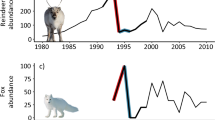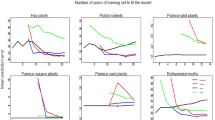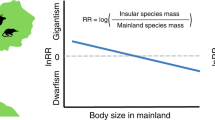Abstract
Replying to J. B. Losos & R. M. Pringle Nature 475, 10.1038/nature10140 (2011)
We agree with several of the points raised by Losos and Pringle1, but we show here that our data2 still implicate competition as an agent of natural selection, while providing only limited support for a role of predation. Although patterns of density-dependent survival and selection on Kidd Cay are highly congruent with those on experimental islands, this site could be considered fundamentally different. We therefore base our rebuttal on analyses that use mean values per island (as in our original paper2) but which now exclude Kidd Cay (n = 6 experimental islands).
Similar content being viewed by others
Main
We agree that an ideal experimental design would balance predator treatments across years, but we note that the benefits of large-scale experiments often outweigh necessary sacrifices in replication3,4. Given that survival was higher in 2008 than in 2009, some of the treatment effects on survival in our Fig. 1 (ref. 2) do reflect year effects. However, during 2009, the year in which all predator treatments were included, survival of males still tended to be lower on islands exposed to bird and snake predators (mean survival = 0.20, 0.30) than on other islands (0.34, 0.35) (generalized linear model (GLM) with identity link function: χ2 = 2.68, P = 0.10; n = 4). More importantly, there is no evidence that predators influenced selection on any trait, whether year effects are included (GLM: all P > 0.26) or excluded (GLM: all P > 0.33). The same is true when analyses are restricted to 2009 (GLM: all P > 0.21; n = 4). When individual survival (0 or 1) is analysed as the response variable, predator treatment affects overall survival in 2009 (GLM with logit link: χ2 = 47.59, P < 0.0001; n = 323), yet no treatment×phenotype interactions are significant (GLM: all P > 0.43). This comparison does not provide replication at the population level, but it strongly suggests that predators had little effect on phenotypic selection.
By contrast, population density tends to be associated with phenotypic selection regardless of whether density is treated as a categorical (high/low) variable (GLM all with identity link for snout–vent length: χ2 = 3.15, P = 0.08; hindlimb length: χ2 = 3.32, P = 0.07; stamina: χ2 = 5.01, P = 0.03) or as a continuous variable in analyses including year effects (GLM for snout–vent length: P = 0.25; hindlimb length: P = 0.04; stamina: P < 0.001). Moreover, a two-factor GLM (identity link) with predator and density treatments reveals a significant effect of density, but not predators, for selection on snout–vent length (density: χ2 = 4.51, P = 0.03; predators: χ2 = 2.46, P = 0.29) and stamina (density: χ2 = 6.02, P = 0.01; predators: χ2 = 4.03, P = 0.13). Both density (GLM χ2 = 17.17, P < 0.001) and predators (GLM χ2 = 15.42, P < 0.001) influenced selection on hindlimb length, but predator effects occur because selection was only observed in the absence of predators. Therefore, analyses that exclude Kidd Cay and use only uncorrected selection differentials support the main conclusion of our paper2 by showing that density influenced selection on each of these traits, whereas predators had little effect on selection.
A more general issue is the extent to which lizard density can be interpreted as a surrogate for competition. We agree that the positive correlation between survival and density (Losos and Pringle1, Fig. 1c) challenges this assumption. However, the focal result of our study was to show that the relationship between survival and phenotype changed as a function of density, not that overall mortality differed among treatments. Losos and Pringle1 show that island area is correlated with density and propose the interesting alternative hypothesis that selection could be driven by factors related to island area. We see no reason to consider this a more parsimonious interpretation at present, but we agree that future experiments must explicitly disentangle the effects of density and island area.
References
Losos, J. B. & Pringle, R. M. Competition, predation and natural selection in island lizards. Nature 475 101038/nature10140 (2011)
Calsbeek, R. & Cox, R. M. Experimentally assessing the relative importance of predation and competition as agents of selection. Nature 465, 613–616 (2010)
Oksanen, L. Logic of experiments in ecology: is pseudoreplication a pseudoissue? Oikos 94, 27–38 (2001)
Carpenter, S. R. Large-scale perturbations: Opportunities for innovation. Ecology 71, 2038–2043 (1990)
Author information
Authors and Affiliations
Corresponding author
Rights and permissions
About this article
Cite this article
Calsbeek, R., Cox, R. Calsbeek & Cox reply. Nature 475, E3 (2011). https://doi.org/10.1038/nature10141
Published:
Issue Date:
DOI: https://doi.org/10.1038/nature10141
Comments
By submitting a comment you agree to abide by our Terms and Community Guidelines. If you find something abusive or that does not comply with our terms or guidelines please flag it as inappropriate.



